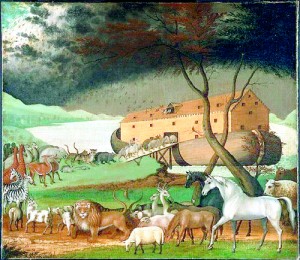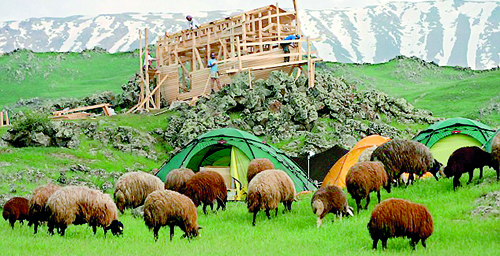Sunday Times 2
Noah could have floated his boat
The story of a man building a giant wooden boat to help his family and the entire animal kingdom survive a terrifying flood is one of the more contentious parts of the Bible.

A group of fourth year master's students from the Department of Physics and Astronomy at the University of Leicester calculated that Noah's ark, built to accommodate at least two of every animal species, would have floated using the dimensions ordained in the Bible
But research by physics students suggests that a structure on the scale of Noah’s ark as described in the ancient text could have been built.
And what’s more, they say it would have been buoyant even with two of every animal on Earth on board.
However, while the ark would have stayed afloat they’re not sure if every animal would have fit inside.
In the book of Genesis, Chapter 6:13-22, Noah is commanded to build an ark to survive a flood.
Noah was provided with exact dimensions for the boat which should be 300 cubits long, 50 cubits wide and 30 cubits high.
It was built to hold Noah, his family, and at least two of every species of animal for the duration of the flood.
Using these dimensions and suitable approximations, University of Leicester physics students Oliver Youle, Katie Raymer, Benjamin Jordan and Thomas Morris tested the instructions and were surprised with their results.
Student Thomas Morris, 22, from Chelmsford, said: ‘You don’t think of the Bible necessarily as a scientifically accurate source of information, so I guess we were quite surprised when we discovered it would work.
‘We’re not proving that it’s true, but the concept would definitely work.’
The students based their calculations on a book by Dr Morris and Dr Whitbomb called The Genesis Flood, which suggested that Noah would have needed to save approximately 35,000 species to repopulate Earth.
This enabled the students to conclude that the dimensions given in the Bible would have allowed Noah to build an ark that would float with all of the animals on board.

The students estimated the ark could have held 2.15 million sheep, which was more than strong enough to carry two of every species (Reuters)
They added that it was a separate matter whether all of the animals would fit inside an ark of these dimensions – the physics students were simply calculating the buoyancy of the ark.
The students presented their findings in a paper for the Journal of Physics Special Topics, a peer-reviewed student journal run by the University’s Department of Physics and Astronomy.
The student-run journal is designed to give students practical experience of writing, editing, publishing and reviewing scientific papers.
Course tutor, Dr Mervyn Roy, a lecturer in the University of Leicester’s Department of Physics and Astronomy, said: ‘The aim of the module is for the students to learn about peer review and scientific publishing.
‘The students are encouraged to be imaginative with their topics, and find ways to apply basic physics to the weird, the wonderful and the everyday.’
© Daily Mail, London
| CHALLENGES THE STUDENTS FACED
The dimensions for the ark were provided in cubits in the Bible, an archaic measure based on the distance between the elbow and the tip of the middle finger. - Noah was commanded to make the boat out of ‘gopher wood’ and in order to calculate the weight of the empty ark they needed to know the density of the material the boat was constructed out of, but there is no modern-day equivalent of gopher wood. - English translations of the Bible refer to cypress wood instead, so this was the material that the students used. - In order to calculate the overall downward force of the ark, the students needed to know the mass of the animals on board; previous research has suggested that the average mass of an animal is approximately equal to that of one sheep, 23.47kg, which was the figure used. - ‘Our conclusions were that the ark would support the weight of 2.15 million sheep without sinking and that should be enough to support all of the species that were around at the time.’ |


